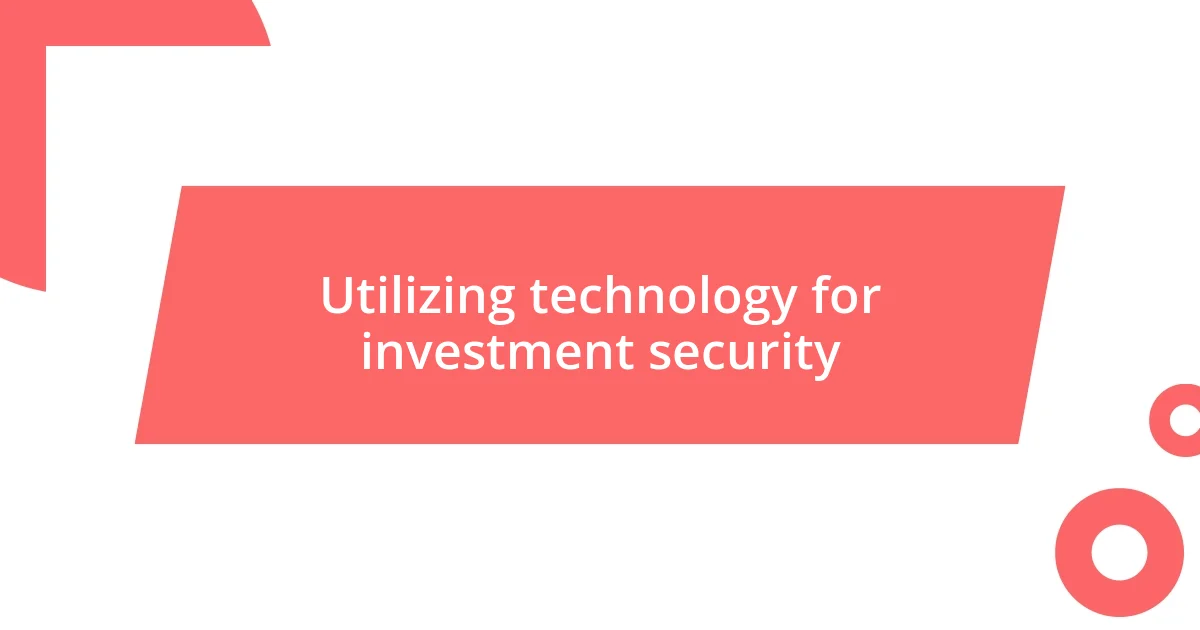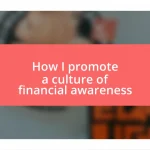Key takeaways:
- Investment security involves protecting assets through strategies like diversification, risk assessment, and understanding market volatility.
- Regular monitoring and proactive management of a diversified portfolio enhance resilience and informed decision-making in changing market conditions.
- Utilizing technology, including investment apps and cybersecurity measures, empowers investors to track performance, analyze risks, and secure their financial assets effectively.

Understanding investment security basics
Understanding investment security basics is fundamental for anyone stepping into the world of investing. I remember the first time I realized how crucial it was to safeguard my investments—protecting my hard-earned money felt just as important as the gains I was hoping to achieve. Imagine putting your trust in investments, only to watch them vanish; it’s a fear that can keep anyone up at night.
At its core, investment security refers to measures taken to protect your investments from loss or theft, ensuring your wealth remains intact. I often think about the various tools and strategies I’ve used, like diversification; it’s a simple concept but incredibly effective. By spreading my investments across different assets, I’ve managed to reduce risks significantly. Have you ever thought about how one bad investment can shake your financial foundation? It’s a stark reminder of why comprehending security basics is vital.
Moreover, understanding market volatility is another cornerstone of investment security. I vividly recall a period of economic downturn, where stress levels were high, and many were scrambling to adjust their portfolios. During that time, I learned firsthand the importance of not only having a secure investment strategy but also remaining calm and not making hasty decisions. It’s often said that patience and knowledge are one’s best allies in turbulent times—do you agree?

Identifying potential investment risks
Identifying potential investment risks requires a keen eye and a thoughtful approach. One of my earlier experiences taught me the real impact of external factors when I invested in a tech startup. I was captivated by the innovation but neglecting to assess market competition led to losses I hadn’t anticipated. Recognizing that risks aren’t just about the investment itself but also about the larger context—like industry trends and economic fluctuations—is crucial.
When evaluating investment risks, consider the following aspects:
- Market Conditions: Is the overall market stable, or are we facing volatility that could affect performance?
- Company Fundamentals: Analyze the financial health of the company you’re investing in. Are there red flags in their balance sheet?
- Sector Risks: Different sectors have different risks. For example, the healthcare industry may face regulatory changes, while technology could be impacted by rapid changes in consumer preference.
- Geopolitical Factors: How might political events, trade tensions, or even natural disasters affect your investment?
- Liquidity Risk: Is it easy to sell your investment if you need to? Some investments may tie your funds up longer than expected.
Understanding these potential risks has helped me build a more resilient investment strategy, enabling me to make informed decisions and avoid costly surprises.

Developing a comprehensive risk assessment
Developing a comprehensive risk assessment is a vital step in ensuring investment security. I’ve often found that creating a risk matrix—a tool to visually represent potential risks based on their likelihood and impact—can be incredibly enlightening. The first time I sat down to map this out, I was astounded by how many threats I hadn’t considered. It made me realize that thorough analysis doesn’t just inform your decisions; it is, in fact, a cornerstone of building long-term wealth.
When diving into risk assessment, I think it’s important to evaluate both quantitative and qualitative factors. For instance, while market data can provide numerical insights about potential volatility, personal biases and emotional responses can play a huge role in my investment behavior. I vividly recall a time when I let the fear of a market dip cloud my judgment, prompting me to sell prematurely. Now, I strive to balance objective data with my intuition, fostering a more holistic view of risk.
One practical way I’ve approached this comprehensive assessment is through regular portfolio reviews. It’s like maintaining a fitness routine; I’m regularly checking my investments to identify any that might be underperforming or misaligned with my goals. This proactive stance assures me that I’m aware of what’s happening in my investment landscape. Have you ever taken the time to reflect on your investments this way? It can truly alter your perspective and give you a greater sense of control over your financial future.
| Factor | Description |
|---|---|
| Market Conditions | Evaluating current market trends and economic stability |
| Company Fundamentals | Analyzing the financial health and performance metrics of companies |
| Sector Risks | Understanding risks specific to the industries you’re investing in |
| Geopolitical Factors | Assessing how political events could impact investments |
| Liquidity Risk | Considering how easily an investment can be sold or converted to cash |

Creating a diversified investment portfolio
Creating a diversified investment portfolio is like assembling a balanced meal. I learned this lesson the hard way when I focused too heavily on a single industry, thinking I could maximize my returns. The year my chosen sector faced an unexpected downturn, I found myself scrambling while my peers enjoyed a mix of stable and rising investments. This experience reinforced my belief that spreading investments across various asset classes can protect against market volatility.
I often think about the emotional aspect of investing when I consider diversification. It’s not just about numbers; it’s about peace of mind. For instance, during the 2020 market fluctuations caused by the pandemic, my diversified portfolio acted like a safety net. While some investments dipped, others in different sectors remained strong, reducing my anxiety and allowing me to make more strategic decisions. Have you ever felt that sinking feeling when one investment falters? With a diversified approach, you can alleviate much of that stress.
Furthermore, actively managing this diversity has become a regular part of my investment routine. I remember setting aside time each quarter to reassess my mix of stocks, bonds, and even alternative investments like real estate or commodities. This hands-on approach not only bolsters my confidence but also keeps me engaged with my portfolio. I often ask myself: what have I learned from the shifts in my investments? That reflective practice ensures I adapt to changing market conditions while maintaining a well-rounded investment strategy.

Monitoring investment performance regularly
Regularly monitoring investment performance is something I consider critical for staying on top of my financial game. It’s like checking the pulse of my portfolio. I remember one time when I noticed a stock I had chosen was lagging behind its peers. That prompted me to dig deeper, leading to the discovery of underlying issues I hadn’t initially considered. It’s those moments of vigilance that can make all the difference in my investment decisions.
I also find that setting aside time each month to review my investments creates a solid habit. During these sessions, I assess not only the numbers but also the narratives driving market changes. For instance, after an unexpected earnings report shook my confidence in a tech stock, reflecting on my investment strategy helped me decide whether to weather the storm or pivot to something else. Don’t you just love those “aha” moments when you realize the connection between current events and your own financial choices?
Ultimately, it’s not just about numbers on a screen. Tracking the performance of my investments has taught me resilience. I remember feeling anxious during a market dip, but regularly checking in with my portfolio helped me stay grounded. It made me realize that investing is a journey, not a sprint. With this kind of continuous monitoring, I secure my investment strategy in a way that fosters both patience and growth.

Utilizing technology for investment security
Utilizing technology for investment security has transformed my approach significantly. I recall the excitement I felt when I first harnessed investment apps that provided real-time data and alerts. It was a game-changer! Suddenly, I was no longer waiting for monthly reports; I could track my investments daily, allowing me to react swiftly to market movements. Have you ever felt that rush of empowerment when you know you’re in control? That’s exactly what technology can offer.
Another tool I swear by is the use of advanced analytics and artificial intelligence. These platforms analyze extensive market trends and provide insights that would take me hours to compile manually. I remember testing one AI tool that highlighted potential risks in my portfolio before I even noticed them. Not only did it help me avoid a loss, but it also gave me the confidence to make smarter, informed decisions. How comforting is it to know that technology can act like a safety net?
Lastly, cybersecurity has become a non-negotiable aspect of my investment strategy. I had a jarring experience when I received an alert about an unauthorized login attempt on my trading account. It was a wake-up call. Since then, I’ve prioritized two-factor authentication and strong passwords for all my investment accounts. I’ve learned that the security of my investments is just as critical as the investments themselves. So, what measures are you taking to ensure your financial safety in this tech-driven world?












